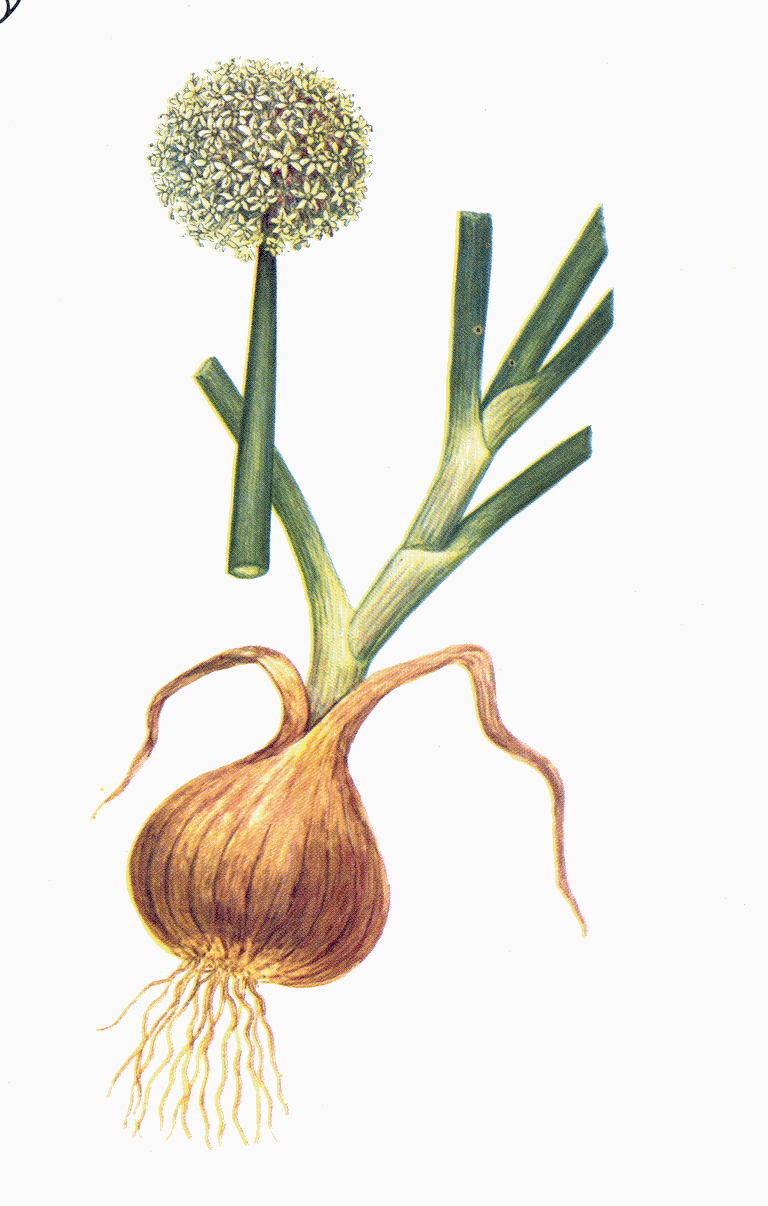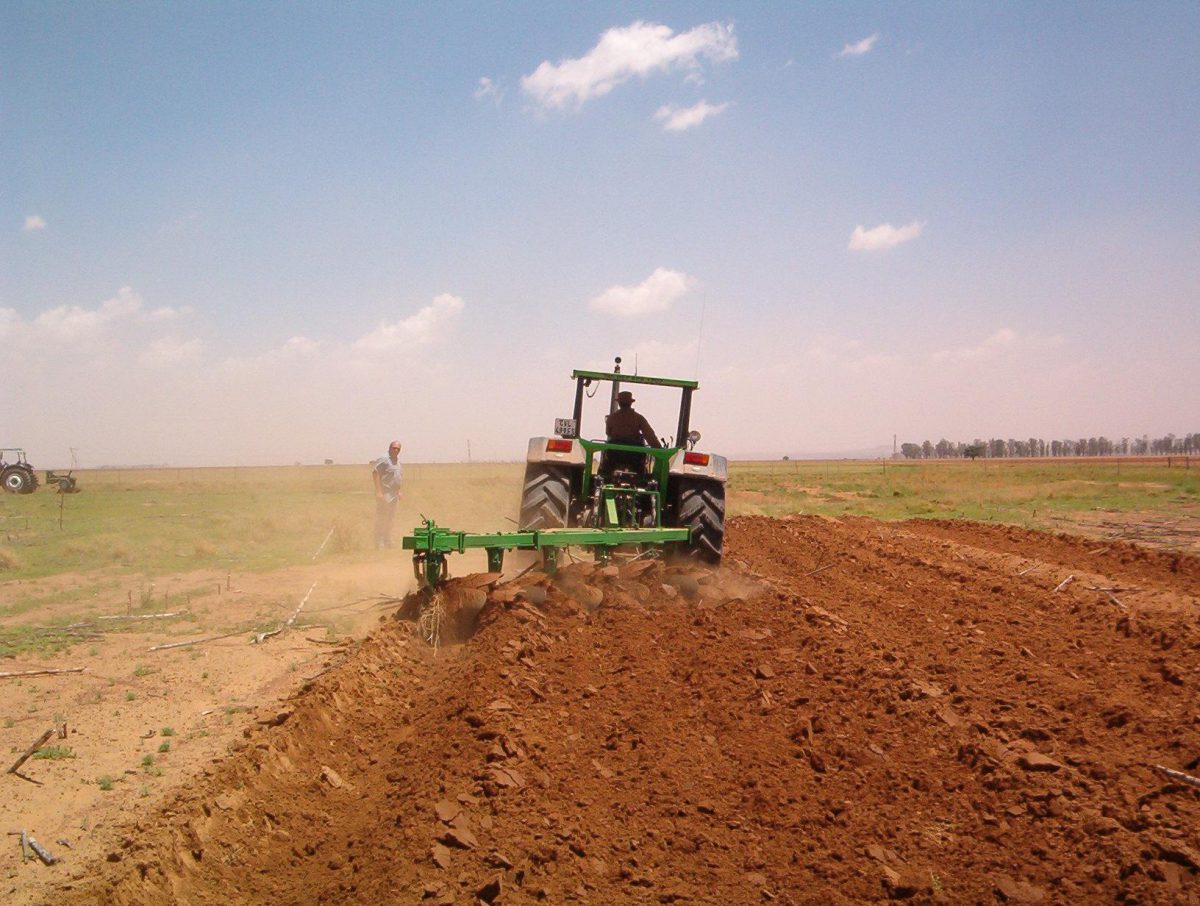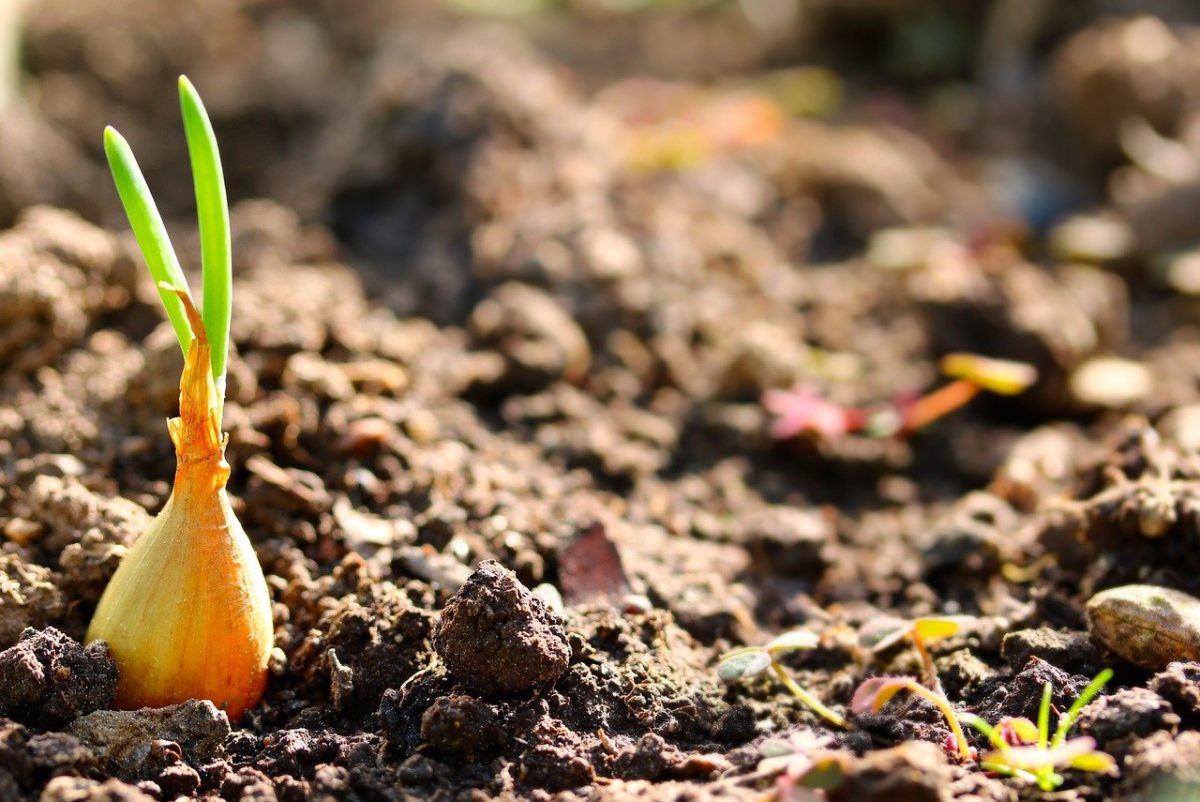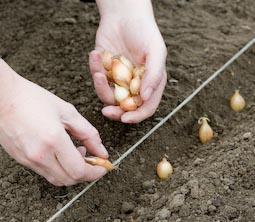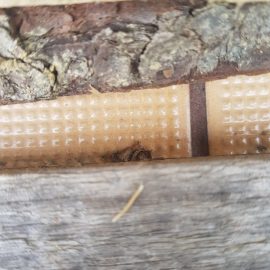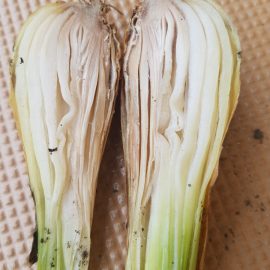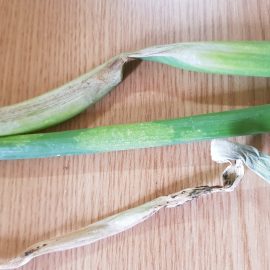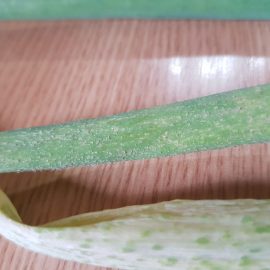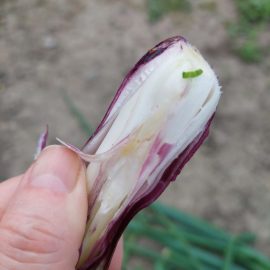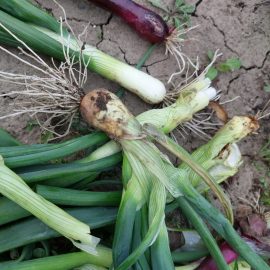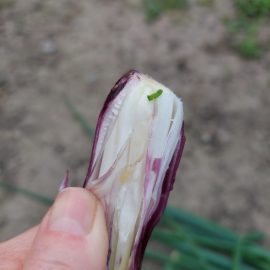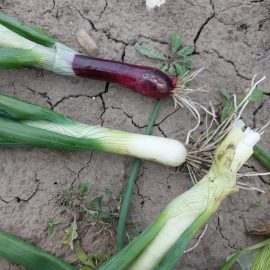Onion, information about crop management
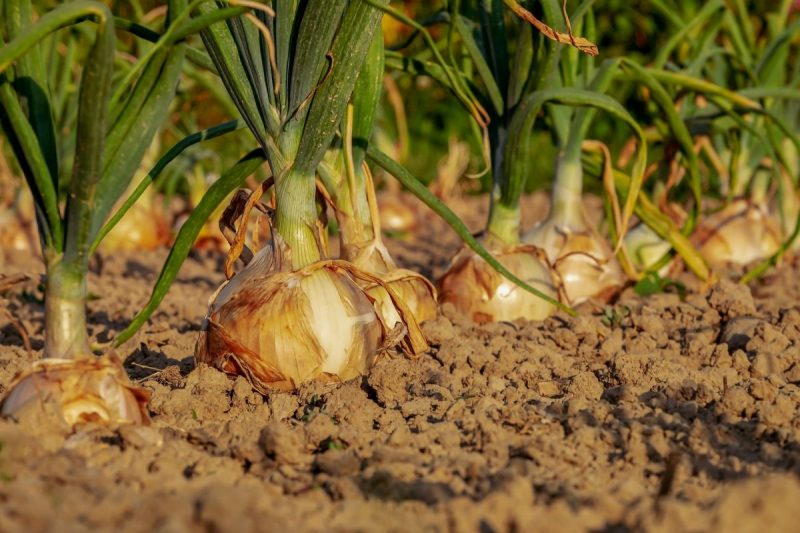
Onion (Allium cepa) is a bulbous plant, cultivated both for the underground parts and for the aerial parts. It is used in human nutrition, in the form of green onions and bulbs, which are used in various dishes. Along with nutrients, onions also contain volatile substances with sulfur, which have antibiotic action. Also, the volatile aromatic compounds in bulbs and onion seeds have a toxic effect on some fungi, parasitic bacteria, and nematodes.
Onion is native to Asia and is a species cultivated since antiquity in the Nile Valley. From Egypt, it spread to Europe and then to America. Currently, the largest onion producers are Russia, the USA, China, India, Turkey, and Japan. In temperate climates, the onion is a biennial or triennial plant. In the case of biennial onions, in the first year of cultivation, the plant forms the leaf rosette, the false stem, and the bulb, and in the second year, it forms flowers and seeds.
The bulb is a round or flattened vegetative organ and results from the stem protected by overlapping sheaths. The leaves are tubular, fistulous, and covered with wax. The flowering stem appears in the second or third year, has a height of 50-150 cm, and is spindle-shaped. The seeds are small, with hard, black tegument.
Climate and soil requirements
Young plants can withstand temperatures of up to -8 ℃, but in order to grow, onions need temperatures above 18 ℃. Due to the poorly developed root system, onions need moisture in the soil to a depth of 30-40 cm. Insufficient water prevents bulbs from growing. Onions will not grow in shady places, needing 14-16 hours of light during bulb formation.
Cultivation
OBTAINING ONION SETS
Crop rotation
Onions can be grown after crops that were fertilized with organic fertilizers, which leave the soil free of weeds. Examples: peppers, early tomatoes, aubergines, cucumbers, early potatoes, courgettes, melons. Beans and peas are not recommended.
Soil preparation
Simultaneously with the plowing, fertilizers can be administered. Then plowing should be done at a depth of about 20-25 cm and the seedbed should be worked to a depth of 5-10 cm. The soil will be shaped into raised beds with a spacing of 150 cm. Pre-emergent herbicides approved for onion cultivation can also be applied.
Recommended products
-
You can find products on a different store
Change Store -
You can find products on a different store
Change Store -
You can find products on a different store
Change Store -
You can find products on a different store
Change Store -
You can find products on a different store
Change Store -
You can find products on a different store
Change Store -
You can find products on a different store
Change Store -
You can find products on a different store
Change Store -
You can find products on a different store
Change Store -
You can find products on a different store
Change Store -
You can find products on a different store
Change Store -
You can find products on a different store
Change Store -
You can find products on a different store
Change Store -
You can find products on a different store
Change Store -
You can find products on a different store
Change Store -
You can find products on a different store
Change Store -
You can find products on a different store
Change Store -
You can find products on a different store
Change Store -
You can find products on a different store
Change Store -
You can find products on a different store
Change Store -
You can find products on a different store
Change Store -
You can find products on a different store
Change Store -
You can find products on a different store
Change Store -
You can find products on a different store
Change Store
Sowing
It is done between 10 and 20 March, in the form of 7 rows per layer, 15 cm apart, with a sowing depth of 1.5-2 cm. The quantity of seed per hectare is 80-100 kg.
Recommended products
-
You can find products on a different store
Change Store -
You can find products on a different store
Change Store -
You can find products on a different store
Change Store -
You can find products on a different store
Change Store -
You can find products on a different store
Change Store -
You can find products on a different store
Change Store -
You can find products on a different store
Change Store -
You can find products on a different store
Change Store -
You can find products on a different store
Change Store -
You can find products on a different store
Change Store -
You can find products on a different store
Change Store -
You can find products on a different store
Change Store -
You can find products on a different store
Change Store -
You can find products on a different store
Change Store -
You can find products on a different store
Change Store -
You can find products on a different store
Change Store -
You can find products on a different store
Change Store -
You can find products on a different store
Change Store -
You can find products on a different store
Change Store -
You can find products on a different store
Change Store -
You can find products on a different store
Change Store -
You can find products on a different store
Change Store -
You can find products on a different store
Change Store -
You can find products on a different store
Change Store
Care works
- In dry years it is recommended to irrigate the crop, with norms of 300 cubic meters/ha;
- The crop should be hoed 2-3 times.
- Additionally, it is recommended to roll the crop 2-3 weeks before harvest.
- Another important work is weed control, which is carried out using approved herbicides.
Recommended products
-
You can find products on a different store
Change Store -
You can find products on a different store
Change Store -
You can find products on a different store
Change Store -
You can find products on a different store
Change Store -
You can find products on a different store
Change Store -
You can find products on a different store
Change Store -
You can find products on a different store
Change Store -
You can find products on a different store
Change Store -
You can find products on a different store
Change Store -
You can find products on a different store
Change Store -
You can find products on a different store
Change Store -
You can find products on a different store
Change Store -
You can find products on a different store
Change Store -
You can find products on a different store
Change Store -
You can find products on a different store
Change Store -
You can find products on a different store
Change Store -
You can find products on a different store
Change Store -
You can find products on a different store
Change Store -
You can find products on a different store
Change Store -
You can find products on a different store
Change Store -
You can find products on a different store
Change Store -
You can find products on a different store
Change Store -
You can find products on a different store
Change Store -
You can find products on a different store
Change Store
Pests and diseases
Among the main diseases that can occur in this crop, we mention downy mildew, early blight, rust, brown spot, and among pests: onion fly, and thrips.
Harvesting and storage
Harvesting can be carried out manually or mechanized, in June. After harvesting, the onion sets are left exposed to the sun for 5-6 days, then collected, sorted, and conditioned. The onion sets should be stored in special warehouses, at temperatures of 1-2 ℃, to avoid the vernalization process. The relative humidity should be 50-70%.
OBTAINING BULBS
Crop rotation
Onions can be grown after crops that were fertilized with organic fertilizers, which leave the soil free of weeds. Examples: peppers, early tomatoes, aubergines, cucumbers, early potatoes, courgettes, melons. Beans and peas are not recommended.
Soil preparation
In autumn, ploughing is carried out at a depth of 28-30 cm after chemical fertilizers have been applied. In spring, you can apply nitrogen fertilizer and pre-emergent herbicides. The germination bed should be made with a combiner at a depth of 5-10 cm and the soil can be shaped into raised beds at a depth of 150 cm.
Recommended products
-
You can find products on a different store
Change Store -
You can find products on a different store
Change Store -
You can find products on a different store
Change Store -
You can find products on a different store
Change Store -
You can find products on a different store
Change Store -
You can find products on a different store
Change Store -
You can find products on a different store
Change Store -
You can find products on a different store
Change Store -
You can find products on a different store
Change Store -
You can find products on a different store
Change Store -
You can find products on a different store
Change Store -
You can find products on a different store
Change Store -
You can find products on a different store
Change Store -
You can find products on a different store
Change Store -
You can find products on a different store
Change Store -
You can find products on a different store
Change Store -
You can find products on a different store
Change Store -
You can find products on a different store
Change Store -
You can find products on a different store
Change Store -
You can find products on a different store
Change Store -
You can find products on a different store
Change Store -
You can find products on a different store
Change Store -
You can find products on a different store
Change Store -
You can find products on a different store
Change Store
Planting
This work shall be carried out in autumn, between 10 September and 1 October, and in spring between 10 and 20 March. Planting can be done manually or mechanically, as follows: 4 rows on the raised bed, 28 cm between rows, and 3 cm between plants. Planting depth varies depending on the soil, from 2 cm to 5 cm.
Care
- Fertilization should be done by applying fertilizers when the bulb thickens and when the first 3-5 leaves form.
- Under normal conditions, 2-3 irrigations must be applied, using a standard of 300 cubic metres/ha.
- Weed control is carried out chemically or by manual or mechanized hoeings.
Recommended products
-
You can find products on a different store
Change Store -
You can find products on a different store
Change Store -
You can find products on a different store
Change Store -
You can find products on a different store
Change Store -
You can find products on a different store
Change Store -
You can find products on a different store
Change Store -
You can find products on a different store
Change Store -
You can find products on a different store
Change Store -
You can find products on a different store
Change Store -
You can find products on a different store
Change Store -
You can find products on a different store
Change Store -
You can find products on a different store
Change Store -
You can find products on a different store
Change Store -
You can find products on a different store
Change Store -
You can find products on a different store
Change Store -
You can find products on a different store
Change Store -
You can find products on a different store
Change Store -
You can find products on a different store
Change Store -
You can find products on a different store
Change Store -
You can find products on a different store
Change Store -
You can find products on a different store
Change Store -
You can find products on a different store
Change Store -
You can find products on a different store
Change Store -
You can find products on a different store
Change Store
Pest and disease control
It is an important step and is carried out using approved products, depending on the disease/ pest.
Harvesting
It starts at the end of July until mid-August. It is recommended to prune the crop before harvesting because this work speeds up the bulb’s ripening. After harvesting, the onions should be left in the field for a few days to dry, then cleaned of leaves, sorted, and stored.














































































































































































































































































































































































































































